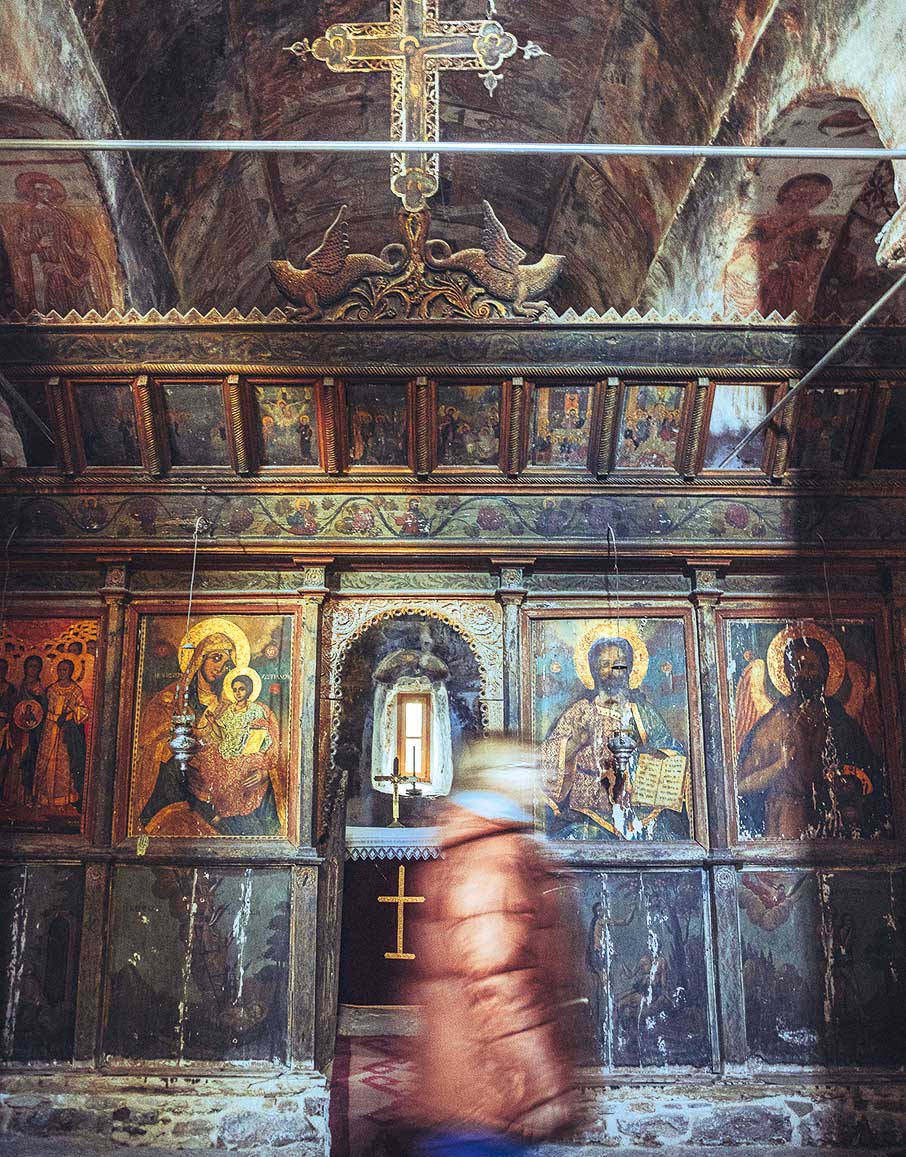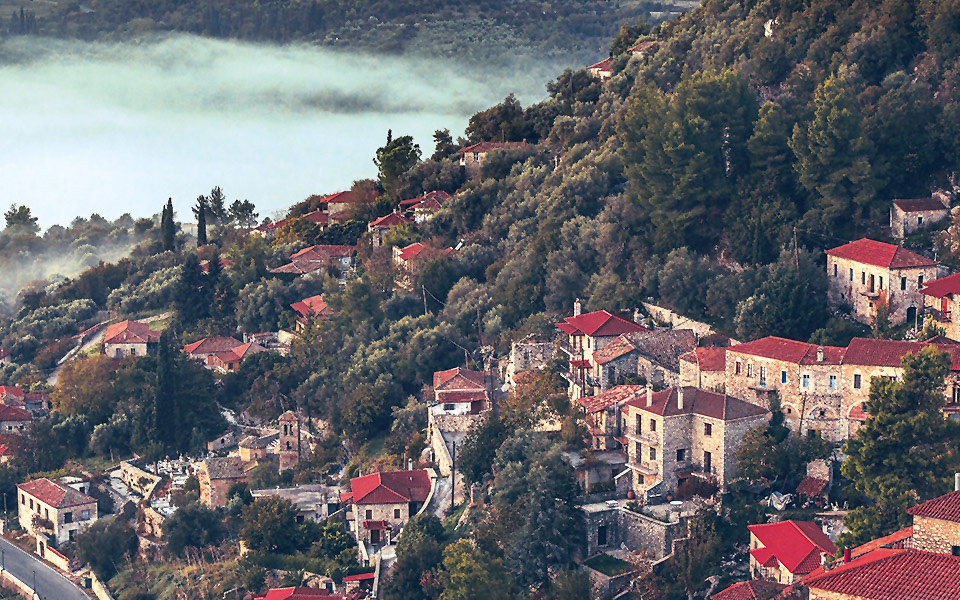The village of Ampeliona appears to be in the middle of nowhere, along the border of Arkadia, Messinia and Iia, among forests bursting with chestnut and oak trees, and enchanting ravines. Yet, wherever you look you can see signs indicating hiking trails, electric bicycles overtaking you, peaceful faces who have just completed their retreats basking in the sun with the few locals, outside the kafenion (traditional coffee shop).
Ampeliona is the village of the Angelopoulos family; Nikos Angelopoulos, founder of the Aldemar Resorts group and brother of director Theodoros Angelopoulos, was dedicated to keeping it alive, changing its fate and making it a destination in its own right, thus completely refurbishing it and creating a luxury guesthouse.

© Nikos Boutsikos, Nidibou Photography

© Nikos Boutsikos, Nidibou Photography
Playing in waters and on bridges
“Stop rowing! The walk is beginning!” shouts our guide with enthusiasm as he lets the inflatable boat hit against a rock, bounce across to the other side, turn around and flow down a small waterfall. All of this, with us still inside. He immediately gives out the orders: “Keep rowing, straight ahead,” “everyone on the left” and other such commands, which make us feel responsible for our fate as we float along the Alfeios River.
In reality, of course, it is clear that our role is purely decorative. “Rafting in this area is the most special in Greece since, together with Arachthos River, it combines natural beauty with moderate action. It is not a boat ride, but it doesn’t require much experience either. In addition, it is accessible nearly all year around and is ideal for everyone,” says Alekos, who leads hundreds of people along the river every weekend – visitors from Karytaina and from the villages in northern Arkadia. The two rivers cannot be accessed during ten days in the winter, when the waters can overflow quite dangerously.

© Nikos Boutsikos, Nidibou Photography
A lesser kestrel flies just above our heads, a startled kingfisher flutters through the leaves, the firs are unprecedentedly large and thick, the plane trees and many other tree species create small “stoas.” We flow into another world, tranquil, peaceful, unaffected by modern living. As a nature lover, the need for contact with the natural world and man’s urge of invading ecosystems without leaving space for wildlife is a constant struggle within me. Of course, in Arkadia, people have always taken advantage of the waters of the river for their needs: they would fish, swim, and build watermills – everything was powered by water in the pre-industrial age.

© Nikos Boutsikos, Nidibou Photography
This exciting route will take two hours, traversing a stone bridge, a beach for swimming, and rocks like sculptures. We duck to avoid the branches, in some places we encounter strong currents and tough crossings-steps, in other places still waters, eddies and a conflux (where two rivers meet). We end up at the 19th century Koukos bridge and from there, after a 5-minute walk along the path and river bed (caution needed in the winter), we reach the Vrontous waterfall, which falls from a 15-meter height and remains one of the area’s best kept secrets.
The other experience that you really need to try here is rappelling from the Karytaina bridge. The high, modern bridge stands 35 meters above the main road. The expert guides will set you up with the appropriate gear and in a few minutes, you will find yourselves dangling over the void. If you keep your calm, you will admire the plains, the Alfeios Valley, Karytaina further up, Megalopoli further away, and of course, the old stone Karytaina bridge that dates from the 13th century, next to which you will eventually land.

© Nikos Boutsikos, Nidibou Photography
A trail for Zeus
Karytaina and Ampeliona meet on Mount Lykaios, a mountain that is not very tall (1,420 meters) but imposes over the valley of Megalopoli. They say that Zeus was hidden as a newborn on this sacred mountain, where he was raised by the nymphs Theisoa, Neda and Agno. His worship seems to begin from prehistoric times and they say that even human sacrifices were performed in his honor. According to the myth, nobody could see their shadow in the holy shrine of Zeus, and those who stepped into the sanctuary would die within a year.
The locals feel proud of the Lykaion Games that were held here in antiquity, and even go so far as to revive them every summer with cultural and athletic events. Further down the mountain slopes you will also see a few remains of the Hippodrome, the Stadium and the Guesthouse. The altar of the temple of Zeus Lykaios was on the Ai-Lia peak, which you can access by car from Karytaina or Trail 4 from Ampeliona (“The Sacred Trail”). You will need to walk for 10 minutes to reach the top. And even though there are no traces of ancient worship up there anymore, it is worth going just to admire the views over half the Peloponnese.

© Nikos Boutsikos, Nidibou Photography

© Nikos Boutsikos, Nidibou Photography
The legends of Karytaina
The first light of day struggles to pierce the blanket of fog above Karytaina. It falls on the stately mansions, its famous castle and the Alfeios ravine. More renowned for its bridge, the so-called “5000 drachma bill bridge” depicted on the banknote together with Theodoros Kolokotronis, it is also famed for its history and legends that the locals will take every opportunity to share with you. One of them talks about an earlier bridge that was unstable and constantly toppled by the waters of the river, until the lord of Karytaina’s castle, Godfried de Bruyere, “built” his wife into its foundations. In search of consolation he then pursued the wife of his assistant, Domestihos Katavas. They eloped and he even abandoned his castle for her. The betrayed husband buried his woes by taking power and becoming the ruler of the castle.
It is this castle that also makes Karytaina (also known as Karitena) stand out. It was built in the 13th century, by the Franks, using building materials from the ruins of ancient Vrenthi that was located here. They say the villagers quickly transported the stones to the top of the hill by hand, in view of an impending invasion by Slavs. Later the castle was bought by Andronikos Palaiologos and then fell into the hands of the Ottomans. But Kolokotronis and the locals managed to oust them and made it their hideout, from where they would attack Ibrahim.

© Nikos Boutsikos, Nidibou Photography
Even though its gates will be closed for the coming year, for restoration works, it is worth taking this wonderful walk to admire the view and also visit the Church of the Virgin Mary, which is open to the public (every, 10:00 – 12:00) and the restored Mantzouranis Tower. The other tower worth seeing is Leventaina (everyday, 08:00 – 10:00), while the only Byzantine monument open to the public is the Church of Agios Nikolaos (everyday, 12:00 – 14:00, if the guard’s contract is renewed). If you visit on the 6th December, you will also have the opportunity of attending the church service at night, a “leftover” from Ottoman times.
You will also walk around the charming neighborhoods to admire the characteristic Arkadian architecture: two and three-storey houses dating from the 18th and 19th centuries, almost all of them restored even though they are not all inhabited, long, rectangular and facing the east, with trellis windows from carved cornerstones.
In the Agora and along the sides of the main road you will find cafes and small tavernas, and some of the village’s 150 permanent residents, who are always willing to narrate their stories: about Kolokotronis and what they believe to be his house, about the church museum in the works, about the 1.5 hour footpath that leads to Kavia Cave, as well as the Alfeios Trail that is finally being planned.
At dusk you will reach Piso Mahala to listen to the Alfeios River roaring in the depths below, scops owls hooting in the forests and the locals gazing out and telling their stories. One of them, Ms. Vaso, approached me and began speaking to me, even without me asking: “Alfeios was a god or a hunter. He was in love with Arethousa. She hid from him and traveled to Ortygia. Then he transformed himself into a river to go find her. Listen to its roar, it is from love.”

© Nikos Boutsikos, Nidibou Photography
Apollo Trails: footpaths for everyone
The Ampeliona Apollo Trails network, featuring eight biking trails and nine hiking routes – all of them boasting special names such as the trail “of Love,” “Eudaimonia,” “Innocence,” etc. – traverses a variety of landscapes, from forests to rocky mountains and ravines. It also unites the area’s most important points, such as the Temple of Apollo Epicurius, the ruins of the temple of Pan, the Neda Springs and the altar to Zeus on Mount Lykaion. The most beautiful is the one leading to the Temple of Apollo Epicurius (7.5km), which traverses three different landscapes, the shortest trail is the cobbled footpath leading to Pigi Tritseli (15 minutes) and the most dreamy is the circular route that passes by the Temple of Pan (10km) through the wild vegetation of the ravine.
In other respects, Ampeliona has well-kept buildings, wooden signs, lamp posts, a small taverna open during the week and the luxurious Ampeliona Retreat guesthouse. It also has 16 residents (and nine more including the guesthouse’s employees), which you will meet one by one as they take walks around the village and engage in discussions outside To Magazaki Tou Spirou, above which a bookstore selling rare editions will soon open.

© Nikos Boutsikos, Nidibou Photography
Two great archaeological sites
Karytaina and Ampeliona are located very close to two important archaeological sites. Open to the public though slightly abandoned, Ancient Gortyna seems to have been the site of some of the most important ancient baths, while excavations have also revealed two acropoleis, two Asklepions and two temples – hardly discernible any more. You will take a peaceful walk by Polygenis bridge and Lousios Beach, admire the baths dating from the 4th-3rd century BC, which operated with a hypocaust system (hot air circulating below the floor) and feature individual baths, a cistern, a central bathhouse and a steam room.
The Temple of Apollo Epicurius on the other hand, recognized as a UNESCO World Heritage Site, is in very good condition and well protected. They say that the residents of Figalia dedicated the temple to Epicurius, initially because he helped them drive the Spartans away but he was then associated with preventing the spread of a pandemic. In any case, the masterpiece created by Iktinos in 420-400 BC, located at an altitude of 1,130 meters in the Bassae area, is simply awe-inspiring. Its uniqueness stems from the combination of Doric, Ionic and Corinthian characteristics, while it also preserves Archaic elements and a different orientation than usual. The temple’s amazing frieze, measuring 31 meters and depicting the Centauromachy and Amazonomachy, is located in the British Museum while, among other things, it’s also the location of the oldest known Corinthian capital. You will learn about all of this via the audiovisual resources in the specially-designed canopy, erected in 1987. The canopy will stay there for as long as the restoration works continue (open daily, 08:30 – 15:30, entrance 6 euros).












